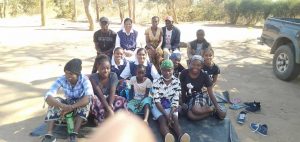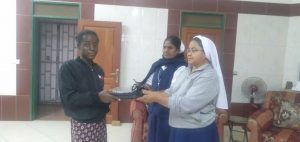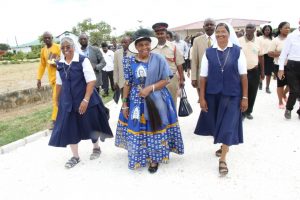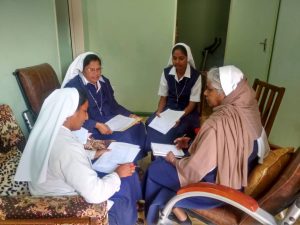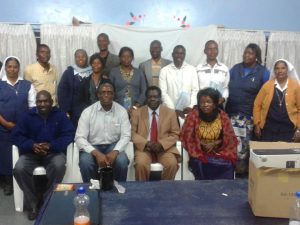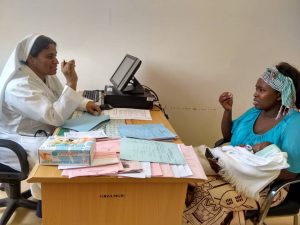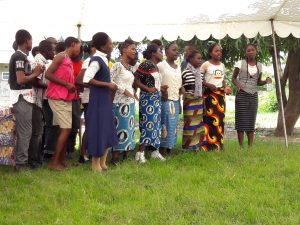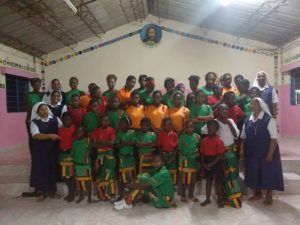Cic Mission in Zambia
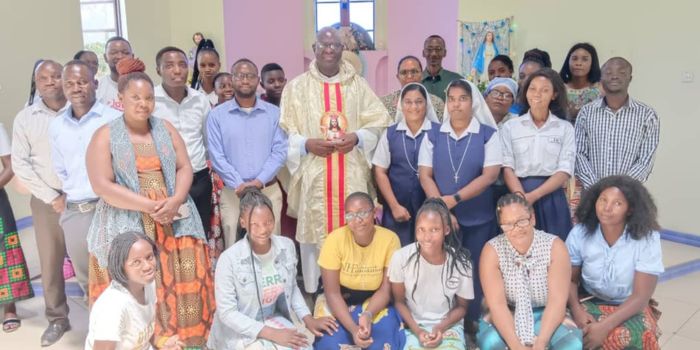
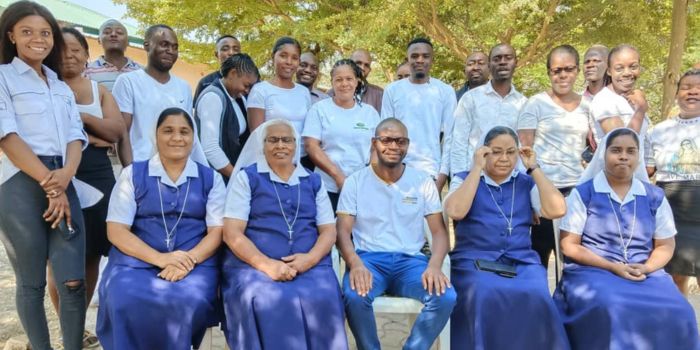

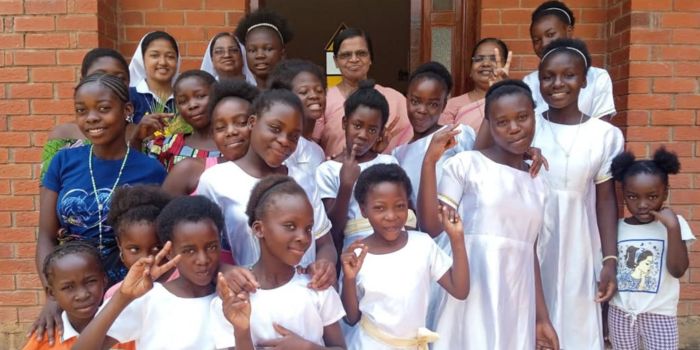
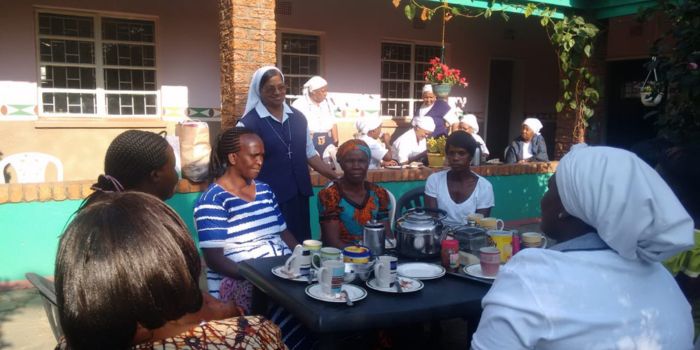
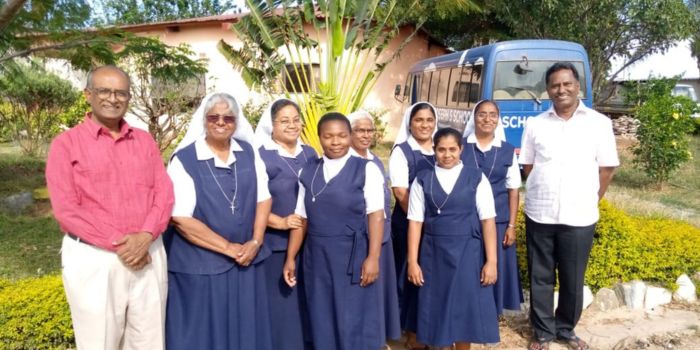
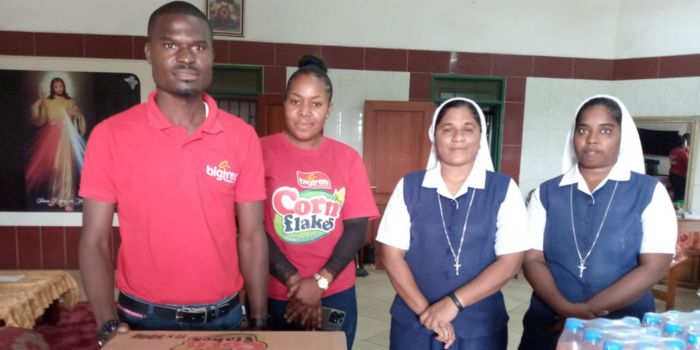
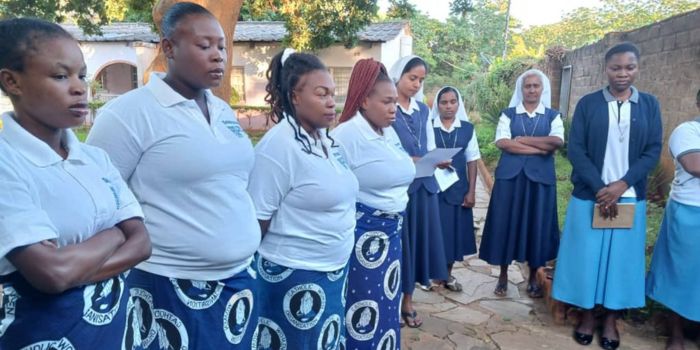

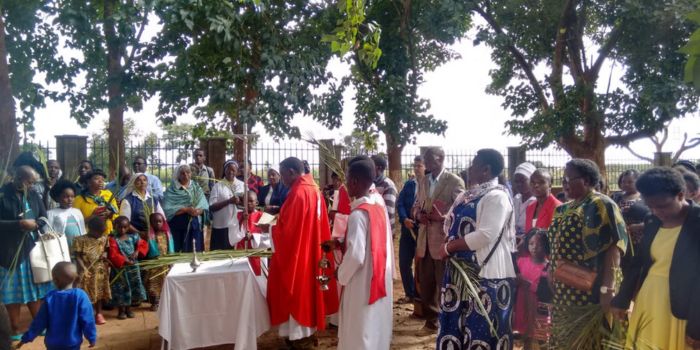
The Pioneering Cic Sisters
After a good preparation, on 16th February 1994 Sr. Realino (Theresa), Sr. Mary Nirmala Justine and Sr. Sahaya Kanaga of CIC reached Zambia from India as pioneer missionaries. Since they were coming for the first time, the Superior G e n e r a l a n d A s s i s t a n t G e n e r a l accompanied them. They started their mission at Marian Shrine and at the Pastoral Centre which belonged to the Archdiocese of Lusaka. Archbishop Adrian Mung’andu was very happy to invite them and placed them in a rented House in Makeni, Lusaka and paid them $ 500 per month. He introduced them to many religious and lay people to help the young plant to grow according to divine providence. CIC Sisters never forget Sr. Sabena the Franciscan Sisters of Assisi Congregation who took care of the Sisters spiritually, morally and taught them everything. Her motherly care made them to feel at home.
Through the encouragement of Archbishop Adrian Mung’andu, Fr. Tomazin S.J, the first Director founded the Marian Shrine and Pastoral Centre. He made the Sisters’ presence fruitful. He was waiting for a longer time for a women’s Congregation to assist in his ministry. He was very happy about the Sisters’ presence and built the present CIC Amala Convent at the M a r i a n S h r i n e , L u s a k a . H e m a d e arrangements for the Sisters to study the local
language and trained them to be real missionaries. The foundation of CIC in Zambia got it roots because of the three devoted persons mentioned above. Really God made use of them as instruments for CIC.
Identification. Zambia derives its name from the Zambezi River. The river runs across the western and southern border and then forms Victoria Falls and flows into Lake Kariba and on to the Indian Ocean.
Location and Geography.in size, the country is roughly equivalent to the state of Texas, about 752,618 square kilometres. The unique butterfly-shaped boundaries are the result of the European scramble for Africa’s natural resources in the early 1900s. The capital is Lusaka. Zambia is a landlocked country located in Southern Africa, to the east of Angola. Zambia is a landlocked country bordered by Zimbabwe in the south, divided by the Victoria Falls, the Democratic Republic of the Congo in the north, Tanzania on the northeast, Malawi on the east and Mozambique on the southeast.
It is a landlocked country with several large freshwater lakes, including Lake Tanganyika, Lake Mweru, Lake Bangweulu, and the largest man-made lake in Africa, Lake Kariba. There are several game parks in the country; some consider Southern Luangwa to be the best game park on the continent.
Zambia, is a landlocked country of rugged terrain and diverse wildlife, with many parks and safari areas. On its border with Zimbabwe is the famed Victoria Falls – indigenously called Mosi-oa-Tunya, or “Smoke That Thunders” – plunging a misty 108m into the narrow Batoka Gorge. Spanning the Zambezi River just below the falls is Victoria Falls Bridge, a spectacular viewing point.
Capital : Lusaka
President : Edgar Lungu
Population : 17.47 million (2018)
National anthem : Stand and Sing of Zambia, Proud and Free
Currency : Zambian kwacha
Zambia lies in the watershed between DR Congo and Zambezi river systems. Leaving two provinces, all other provinces lie in the country frontier formed between the continental divide separating the Atlantic Ocean and the Indian Ocean, which traverses from DR Congo to the south of Tanzania.
Tribes in Zambia
The Zambian peopel. It's a population of less than 15 million, Zambia comprises an amazing 72 ethnic groups, most of which are bantu-speaking. About 90% of the population fall into 9 major ethnolinguistic groups: the Nyanja-Chewa; Bemba; Tonga; Tumbuka; Lunda; Luvale; Kaonde; Nkoya; and Lozi.
Indigenous languages
Seven vernacular languages have official status. Together these represent the major languages of each province: Bemba (Northern Province, Luapula, Muchinga and the Copperbelt), Nyanja (Eastern Province and Lusaka), Lozi (Western Province), Tonga (Southern Province), and Kaonde, Luvale and Lunda (Northwestern Province). These seven languages are used, together with English, in early primary schooling and in some government publications. English, the former colonial language, serves as a common language among educated Zambians. At independence in 1964, English was declared the national language.
Festivals and Ceremonies
Festivals in Zambia are the ideal occasions for merry making in the country. The country of Zambia includes a colourful and diverse culture. One gets a glimpse of the wonderful culture of the region in the Festivals in Zambia. The culture of Zambia is of contemporary type that includes a wonderful blend of values and traditions. The Zambian Festivals are the major source of entertainment for the local people of the region. Most ceremonies have a profound significance in several cases decorated to call upon the memories of the conversion from childhood to adulthood.
The Major Festivals in Zambia are generally celebrated in a traditional way.
The Kazanga ceremony is considered as the most popular and oldest Festivals in Zambia. This festival is celebrated by the Nkoya people for over 500 years in a very traditional way. In this festival you will get a glimpse of Nkoya traditions of music, dance and many other old rituals.
The Nc’wala Ceremony (February ) is mostly celebrated by the Ngoni tribe. The Ngoni people reside in the eastern edge of Zambia which is close to Chipata. The Ngoni people who are the inhabitants of Zambia did not stay there from before. Initially they stayed in South Africa. When they shifted from there, they won many victories over other tribes. The Nc’wala Ceremony in Zambia is held to celebrate the glorious deeds of the tribe. The ceremony starts with the tasting of the first fruit of the year by the chief of the Ngoni tribe. This is followed by much singing and dancing. There are speeches that are given by the members of the community. There is also a grand feast laid out for the entire community.The people of the tribe are dressed in leopard skins and they carry accessories like clubs, shields and feathers. A bull is killed and the chief of the community drinks the blood of the animal and the celebrations start. The members of the Ngoni tribe then rush at the dead animal and tear at the carcass and cut out chunks of the meta'NC ’wala Ceremony, Zambia is designed to bring the members of the community close to each other. It strengthens the bonds among the members of the community.
The Kuomboka Festival (Feb/March)is one of the alluring festivals of the country that sees a huge influx of tourists every year. Among all the ceremonies and festivals, Kuomboka Festival, Zambia is the most attractive one for all. The Kuomboka Festival, Zambia is the most popular of the ceremonies that takes place in the Western Province of Zambia. This festival is celebrated during the month of February or March. Sometimes, this festival is celebrated on a Thursday just before full moon. The exact date would only be known just a week or so in advance since the Lozi king determined it.Zambian CultureThe Zambian Culture consists of a rich diversity of cultural activities since there are 75 ethnic groups. It is divided into ten provinces.Origin of CIC’s entry to the Diocese of MonzeAfter the confirmation of the mission station for the Congregation of the Immaculate Conception in the Archdiocese of Lusaka, the Bishop of Monze Rt. Rev. Paul Lungu took the Superior General and Assistant to his diocese and made arrangements through his Secretary Sr. Philomina for them to visit various places of education of Institutions and social service centres.The visitation of foreign missionary Sisters, the Zambian Sisters and their ministries in the diocese of Monze gave clarity to the Superior General and her Assistant. The plan of starting our education ministry in Mazabuka Girls’ School was chosen by God through the first visitation of that school itself by the Superior General and Assistant even though it was not approved at that time. At that time the social centre in Choma was the one given to the congregation by Bishop. After waiting for one year to receive the reply from the bishop of Monze, the Superior General received the good news in 1995 from the bishop whether the Congregation could like to take on the mission of Mazabuka Girls’ Secondary School instead of Choma Social work Centre for the disabled. Since in their visit itself the Superior General found the education ministry at Mazabuka was an apt one for the Congregation to render service and also it was approved already in the General Council, so she immediately sent the acceptance.ARRIVAL OF THE PIONEERING SISTERS TO ZAMBIA
MARIAN SHRINE LUSAKA
Since the Congregation sent the Sisters for the first time out of India, to start the mission in a foreign country, preparation of the document and preparation of the God
chosen ones for Zambia Mission took one year. God fixed the date as 15/02/1994 Ash Wednesday, after participating in the Holy Mass at Mumbai for the pioneering Sisters
Theresammal Realino, Sr. Nirmala Justine and Sr. Sahaya Kanaga to start their missionary journey from India to Lusaka Zambia. And they landed at Lusaka on 16/ 02/1994.
Archbishop Mung’andu welcomed them and with concern, appointed Sr. Sabina a Franciscan Sister of Assisi to guide and help the Sisters. The God – given instruments, i.e the Archbishop, Sr. Sabina and Fr. Thomazin SJ the first Director of
the Marian Shrine and Pastoral Centre gave the Sisters a lot of inner strength to start their Missionary journey. They were welcomed by Fr. Thomazin SJ the Director at the grotto Marian Shrine and Father introduced them to the people who came for the Sunday mass. Through that their Pastoral ministry started.
Mazabuka
In 1995, the second Mission was started at Mazabuka with the invitation of Rt. Rev. Paul Lungu, the Bishop of Monze and Sr. Leela Philomine, Sr. Patricia and Sr. Mary Delphine were the Pioneers to Mazabuka Mission and the Mazabuka School was handed over to CIC by the Holy Rosary Sisters.
MISSION ADMINISTRATION IN ZAMBIATHE MISSION COORDINATORSSince the community has increased, in 1999 the Superior General Sr. Josephine Alphonsa appointed, Sr. Leela Philomine (1998 – 2002) as the Coordinator for the CIC Sisters and Sr.Jeya Gnanadickam (1998 – 2002) for the CIC Institutions in Zambia.
Kasiya
In 1998, the third Mission was started at Kasiya and Sr. Jeyamary Manicakam, Sr. Annamary Pappu and Sr. Thiravia Regina Rajam were Pioneers to Kasiya to take over the Kasiya Secretarial College from the Irish Presentation Sisters.
Ikelenge
In 1999, the fourth Mission was started at Ikelenge for taking care of the Hearing Impaired Children with the invitation
received from Rt. Rev. Noel O’Regan, the Bishop of Solwezi and with the help of Fr. Pio, of the Franciscan conventicles. Sr. Realino Therese and Sr. Rajamani were the pioneers at Ikelenge near the near the source of the Zambezi river.
Home of Joy
In 1999, His Grace Medardo Joseph Mazombwe, was the Archbishop of Lusaka, he desired to help the orphans and vulnerable children in the Marian Shrine Campus and the Congregation came forward to take up the concept to come true through construction
of the orphanage and on 7th August 2000, the Home of Joy Orphanage was started for the double orphans and the vulnerable in society. Sr. Jeya Ganadhickam was the first director of the Orphanage.
THE FIRST MISSION SUPERIOR SR. I. ALPHONSA (2002 – 2007)
Since God permitted and graced the Congregation, the numbers of Sisters were increasing in Zambia and in South Africa. Therefore the need to start a Mission House and the appointment of a Mission Superior was felt by the Congregation. After the office of the Superior General, Mother I. Alphonsa (Josephine Alphonsa) was appointed as the First Mission Superior of Zambia and South Africa on 29th January 2002 by Rev. Mother Antony Xavier, the Superior General of CIC. She became the Chairperson of the Board of Management of Mazabuka Girls School and Kasiya College after Sr. Jeya Gnanadickam. Sr. Sahaya
Lourdu was appointed as the Mission Secretary and Procurator of Zambia and South Africa Mission. Sr. Anna Mary Pappu, Sr. Nirmala Savarimuthu, Sr. Jeya Gnnanadickam and Sr. Leela Philomine were appointed by the Superior General as members of the Advisory team.
The Superior also made her canonical visitator of the convents of Zambia and conducted a retreat from 22nd to 28th January 2002 for the Sisters in Zambia. She also made her visitation of the Convents in South Africa together with the Mission Superior, Sr. Alphonsa.
During the period of Mother Alphonsa, the Mission Superior, the first time the office of the Mission Administration was put in order. Mission files and records were prepared and maintained. Office equipment was bought. The Congregation was registered by receiving “The Certificate of Exemption from Registration” from the Government of Zambia on 6th August 2004 in the name “CIC Mission in Zambia.”
In order to do the administration fruitfully and successfully, the second hand vehicle (Minibus ABE 40) was bought in 2005. Financial support was made by the Italy Mission during Sr. Stella’s office as Mission Coordinator of Italy.
St. Bakhita convent was opened in 2005 for the Parish ministry in Mazabuka. On the 9th February 2006, a DVD “The joy of being missionary” was produced by the Mission Superior with the help of Mission Press in Ndola. The First Zambian Mission History book “At the Hands of the Lord” was published in the same year.
THE SECOND MISSION SUPERIOR (2007 – 2007 MAY)
Sr. Annamary Pappu was appointed as the second Mission Superior of Zambia in 2006 and Sr. Frasheela was appointed as the Mission Secretary. In May 2007, Sr. Annamary Pappu was elected as the Provincial of Palayamkottai in India. She in her short period of leadership, tried her best to make the Mission to grow; especially, she gave chances for the junior Sisters to strengthen their spirituality.
THE THIRD MISSION SUPERIOR SR. NIRMALA SAVARIMUTHU (2007 TO 2019)
On 3r d September 2007 Sr. Nirmala Savarimuthu was appointed as the third Mission Superior of Zambia. The seed which was planted in Zambia started growing day by day with the help of God. Sr. Ruby Sahaya Rani was appointed as the Mission Secretary and Procurator. Mother General requested Mother Alphonsa to continue to be the Chairperson of the Board of Management in
Mazabuka Girls’ School, Kasiya Business and Secretarial College and Home of Joy Orphanage at Lusaka. In 2011, Sr. Sahaya Lourdu was appointed as the Mission Secretary and in 2016, Sr. Ruby Sahaya Rani was appointed as the Mission Procurator in October 2007, Sr. Nirmala Savarimuthu was appointed as the third Mission Superior of Zambia.
“I say to you, there is no one who has given up house……………..for the sake of the Kingdom of God, who will not receive an overabundant return in this present age and eternal life in the age to come”. (Luke 18: 29-30)
To render service for the people in the compound of Apollo in Mazabuka, in 2008, a New House along with the plot was donated by Fr. Maurizio. CIC convent Bhakitha was moved here. Renovation of the house building was extended with two rooms, toilets and a wall fence built by CIC Mission House.
As the Kasiya College extension established in Monze Campus, Immaculata Convent, at Monze was built in 2009 with the financial assistance of the Congregation. On 9th May 2009, the convent was opened; Sr. Sahaya Lourdu and Sr. Maria Lourdu were the Pioneers of Immaculata Convent at Monze.
In October 2007, Mr. and Mrs. Christopher Lihusha (a Zambian Couple) came forward and donated 5 acres of land to the CIC at Lusaka West Mungwi Road, opposite to Laughing Waters in order to empower the women.
For the Growth of Children with special needs in the District of Solwezi (Hearing impaired, blind and physically challenged children) on 3rd May 2011, 3.5 hectares of land and on 9th May 2011, 1.3 hectares of land were purchased from the City Council of Solwezi, and got a valid Title Deed.
Since the inception of the Mission, drawing up of the advisory committee have been working hard for the development of the Mission in Zambia. The present advisory committee members in 2018 are as follows:
Sr. Nirmala Savarimuthu – Mission Superior
Sr. Sahaya Lourdu – Mission Secretary
Mother Alphonsa – Member
Sr. Lilly Therese – Member
Sr. Rose Varghese – Member
Sr. Rajamani – Member
Sr. Jeasteen – Member
The advisory committee meetings are held three times in a year to discuss the Spiritual Life of the Sisters, Lands, and Ministries of the Sisters and the Development of the Mission.
ST.MONICA CONVENT – SOLWEZI
Background of Solwezi
Solwezi is the headquarters of North Western Province of Zambia. Provincial offices for the Civil and all the ministries are here. In the recent years, because of the new findings of various mines, Solwezi is becoming more popular. The Bishop’s house for Solwezi Diocese is here.
Solwezi has approximately 65, 000 inhabitants at an elevation of 1235 m above sea level. The main industry of Solwezi is copper mining at Kansanshi Mine (located about 10 km north) and Lumwana mine (located about 65 km west), out of the town centre, run by first Quantum minerals and equinox minerals, respectively. kansanshi mine exploits copper-gold ore from kansanshi anticlinal. The mining site has been running since the 19th century for copper and gold successively. Lumwana, on the other hand was discovered in 1961 but no service work was carried out there until equinox minerals ltd became involved in 1999. Uranium is also mined in Solwezi at the Lumwana mine north of Solwezi town.
Tribes
Kaonde is the largest tribe represented in Solwezi, in addition to a large number of Lunda and Luvale speaking people. Three groups with different histories are known as Kaonde; all are probably descended from the Luba people residing in what is now the DRC. The most prominent tribe in Solwezi is the Kaonde people. The Kaonde is tribes that, like the Lunda people, are descendants of the Luba-Lunda Empire of Zaire. They were among the first Zambians to do mining of copper in Zambia as suggested by archaeological evidence at the Kansanshi mine in Solwezi that dates back to the Iron Age. The Kaonde tribe falls under one of the main tribes of Zambia, among the Lozi, the Bemba, the Ngoni, the Tonga and the Luvuale. The Kaonde tribe has about 300,000 people in Zambia and about 30,000people in south DRC.
The congregation has a school for hearing – impaired children in Ikelenge. Since Ikelenge is a very remote area, providing higher education according to the needs of the children was very difficult in terms of teaching vocational skills to the children. From Ikelenge, Sisters have to send their
students for higher studies to Solwezi only. Sisters in Ikelenge together with the Mission Superior Sr. Josephine Alphonsa felt the need for the Special Education school with a hostel for the higher education of the hearing impaired children. So they expressed to Fr. Pio and out of concern he asked the Mission Superior to apply to the Ministry of Lands
Solwezi for a piece of land to build a hostel as a Congregation project for the girls and boys those who are coming for higher studies to Solwezi. He promised to support financially for building construction. So, Sr. Alphonsa together with the recommendation of advisory committee members informed and asked permission f r o m t h e S u p e r i o r G e n e r a l Sr. Antony Xavier regarding place for the hostel for the underprivileged students of Ikelenge who were doing studies in Solwezi basic school. As the permission was granted from the Superior General and the Bishop of Solwezi, Noel O’Reagan , she started the process of receiving the land together with Fr. Pio. Though the ministry of lands approved and they received the letter of offer in the year 2004 to go ahead they could not procede due to some internal problems.HISTORY OF ST.AUGUSTINE CONVENT,LUSAKA WEST – ZAMBIAAfter 13 years of service in Zambia, in 2007, the CIC Mission Administration felt the need to establish a separate residence for the Mission House, Formation House and the development of projects for improving the lives and opportunities of young women in Zambia. All the CIC Sisters in Zambia also s t r o n g l y f e l t t h a t t h e Congregation had to get its roots firmly established in Zambia, especially with the starting of the formation house and having CIC religious women from this soil. Sr. Annamary Papu, the Mission Superior initiated to buy the land or house for the Mission. The then Sr. Nirmala Savarimuthu, the Mission Superior together with Sr. I. Alphonsa, former Superior General and Sr. Ruby, the Mission Secretary with the permission of Rev. Mother Agnes Xavier, the Superior General in September 2007, made a great effort for more than three months to search for suitable land both inside and on the outskirts of Lusaka, such as in Roma, Chilenje, Airport Side, Olympia extension, Sisters of the Daughters of the Redeemer residential area, Chainda Compound, etc. The Indian well-wishers Mr. & Mrs. Wilfred also helped to find a proper place for our Mission. Their tireless effort and prayers were answered by the Lord Almighty through Mother Mary in the person of Mr.and Mrs. Christopher Lihusha.r Lihusha was a Zambian Marian devotee and one of the members of the Marian Shrine committee together with the CIC Sisters. He had been rendering service for the betterment of the Marian Shrine. Long back, there had been a desire in his mind to donate a gift to a Congregation which has Mother Mary as their patron. Since he and his wife Elizabeth knew the CIC Sisters at the Marian Shrine, Amala convent, they were very glad to hear the request when the Sisters expressed to them, their desire to find a piece of land. Through his own advocate, he found out the procedure of making a Deed of Gift for the land that he would donate.HISTORY OF THERESA CONVENT – IKELENGEIntroductionIkelenge is thousand Kilometers from Lusaka, the Capital of Zambia. It is the most remote undeveloped region, in the North Western Province, one of the ten provinces in the country of Zambia. Catholic faith was brought out to this region in1941 by the Franciscan Friars of Ndola. In 2011 Ikelenge was raised into District and it received electricity through hydro power in 2007. The district is bordered the Congo DR in the east and Angola on the west. It is the source of the mighty Zambezi River originating from the Kalene Hills according to geography and lies between the Congo-Zambezi watersheds.
The district has three traditional chiefs and one sub-chief namely Chieftains Ikelenge, chief Nyakaseya and chief Mwinilamba while the sub-chief is called Mukangala. Senior Chief Kanongesha is the overseer of both Ikelenge and Mwinilunga-west by virtue of his traditional powers.
Traditionally the people lived in scattered villages according to families and clans. They lived by hunting, farming and collecting honey as civilization had not yet spread to these parts of the country.
Long ago, before independence the people lived anywhere as there were no boundaries but after independence from Britain, which was the colonial power, in 1964 the country was divided into the provinces and districts. By that time there were no formal schools but what existed were informal schools, where groups were initiated into traditional camps where they were taught survival life skills and how to look after themselves, wives and children. The girls that had become of age were also initiated and elderly women were tasked to tutor them and gave lessons on discipline, cooking, receiving visitors and alternatively to their husbands and families.
As the years went by, formal schools were established in some Localities and teachers were sent to teach the children how to read and write. At that time a missionary by the name of Dr. Walter Fisher had opened up Kalene Mission hospital on top of the hill and later moved it at the foot of the hill where it stands at the present day. This was the beginning of civilization in the district and the changing of the lives for the people from traditional to modern. The dawn of the new era had begun.
HISTORY OF ST. BAKHITA CONVENT –MAZABUKA
Aim of the Convent
“Go out to the whole world; proclaim the Good News to all
creation” (Mk 16:15)
To Preach the Good News to the Poor through the Parish ministry” St.Bakhita Mission was started in the year 2005.
Origin
Since 1995, Sisters in the School community have been rendering education ministry through Mazabuka Girls’ Secondary School. Due to the distance and enough personnel, Sisters were unable to do fulltime evangelization ministry. To do the direct evangelization through the Parish ministry, living among the people in the compound and visiting the sick and suffering, especially those who were affected by HIV/ AIDS, Fr.Maurizio invited our Sisters to live in one of the houses of St.Bakhita’s Association which is in the Apello Compound in Mazabuka. This invitation was gratefully accepted by the Superior General of CIC, the Most Rev.Mother Antony Xavier.
On 15th August 2005, St.Bakhita’s convent was opened by Rev.Mother Antony Xavier; the Superior General during Rev.Mother Josephine Alphonsa was the Mission
Superior with the three Sisters Sr.Ebenezer, Sr.Jeya Manickam and Sr.Leela Philomine to teach in the community school, to do Parish ministry and social m i n i s t r y i n S t . B a k h i t a ‘ s Association. Due to health problem, Sr.Ebenezer was unable to continue her work in the community school.
CIC Sisters’ Education ministry
From the time that the CIC Sisters took up the administration they are spending their whole life for these impaired children by collecting them from the interior bush when the school opens,
keeping them in the boarding, as their own parents they feed, clothe, educate academically, psychologically, spiritually and morally to uplift their status to the level of the normal ones. Because of our Sisters’ presence they could communicate and mingle with society. After the school days the children are being taken back to their house by the Sisters. They drove the vehicle themselves upon the up and down roads and in the rainy season they pass through streams even, to reach the huts of the children. Later on, as the number increased and it became difficult. So the arrangement was the parents would bring them to a the central place which was St. Antony parish Mwinilunga and the Sisters would pick them from there, which was a c t u a l l y s o m e t h i n g t h a t w a s v e r y recommendable. In the beginning Fr. Pio who worked in Ikelenge and Mwinilunga district for a long time also found children in the bush and brought them to the school. In 2000, the only government teacher at the unit passed on and Sr.Realino, the experienced one in teaching and administration took, his place to run the school.
Growth in the Ministry
The Sisters were very much willing to assist the pupils and those came from different places. These children are not mostly found only in Ikelenge district but also found in other places like Mwinilunga district, Solwezi and Mumbezhi. The system that was actually out of reach. Apart from just learning reading and writing the Sisters helped the pupils with life skills such as drawing, painting, and carving. So we could see that a good number of pupils have these skills and the Sisters did that in order to prepare them for their future lives, which was actually a very good thing for the Sisters to do and a good number of pupils have acquired the skills. Interview from the head teacher.
SOUTH AFRICA MISSION HISTORY
Introduction
South Africa is a country located at the southern tip of the African continent. It also includes a small, sub-Atlantic archipelago of the Prince Edward Islands. Neighboring countries include Botswana, Lesotho, Mozambique, Namibia, Swaziland, and Zimbabwe. The geography of South Africa is vast scrubland in the interior, the Namib Desert in the northwest, and tropics in the southeast. The government system is a republic; the chief of state and head of government is the president. South Africa has a mixed economy in which there is a variety of private freedom, combined with centralized economic planning and government regulation. South Africa is a member of the Southern African Development Community (SADC).
The first humans are believed to have inhabited South Africa more than 100,000 years ago. The historical record of this ethnically diverse country is generally divided into five distinct periods: the pre-colonial era, the colonial era, the post-colonial and apartheid eras, and the post-apartheid era. Much of this history, particularly of the colonial and post-colonial eras, is characterized by clashes of culture, violent territorial disputes between European settlers and indigenous people, dispossession and repression, and other racial and political tensions.
The discoveries of diamonds and gold in the nineteenth century had a profound effect on the fortunes of the region, propelling it onto the world stage and introducing a shift away from an exclusively agrarian-based economy towards industrialization and the development of urban infrastructure. The discoveries also led to new conflicts culminating in open warfare between the Boer settlers and the British Empire, fought essentially for control over the nascent South African mining industry.
Following the defeat of the Boers in the Anglo-Boer or South African War (1899–1902), the Union of South Africa was created as a dominion of the British Empire in terms of the South Africa Act 1909, which amalgamated the four previously separate British colonies: Cape colony, Natal Colony, Transvaal Colony and Orange River Colony. The country became a self-governing nation state within the British Empire, in 1934 , following enactment of the Status of the Union Act.


